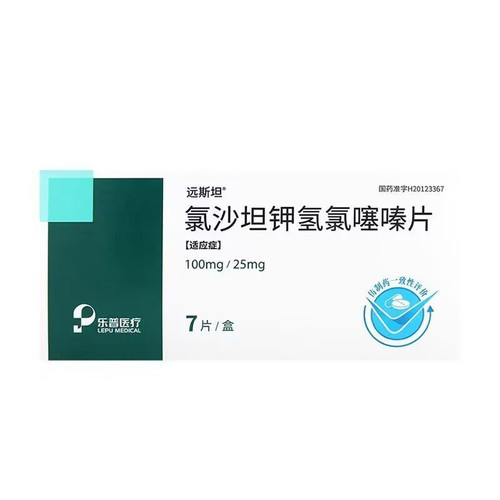Product Overview
[Drug Name]
Generic Name: Losartan Potassium and Hydrochlorothiazide Tablets
Trade Name: AnNeixi
English Name: Losartan Potassium and Hydrochlorothiazide Tablets
Chinese Pinyin: Lushatanjia Qinglusaiqin Pian
[Ingredients]
Main ingredient: Hydrochlorothiazide. Chemical name: 6-Chloro-3,4-dihydro-2H-1,2,4-benzothiadiazine-7-sulfonamide-1,1-dioxide.
[Properties]
This product is a white tablet.
[Indications]
For the treatment of hypertension, suitable for patients receiving combination medication.
[Dosage and Administration]
1. The usual starting and maintenance dose of losartan potassium and hydrochlorothiazide is one tablet (losartan potassium 50 mg/hydrochlorothiazide 12.5 mg) once daily. For patients who have an inadequate response to losartan potassium hydrochlorothiazide 50-12.5, the dose can be increased to two Hyzaar 50-12.5 tablets once daily. The maximum dose is two Hyzaar 50-12.5 tablets once daily. Antihypertensive efficacy is usually achieved within three weeks of starting medication. 2. Losartan potassium hydrochlorothiazide should not be used in patients with reduced blood volume (such as those taking high-dose diuretics). 3. Losartan potassium hydrochlorothiazide is not recommended for patients with severe renal insufficiency (creatinine clearance ≤ 30 ml/min) or abnormal liver function. 4. No initial dose adjustment is required for elderly patients. 5. Losartan potassium hydrochlorothiazide can be used in combination with other antihypertensive medications. 6. Losartan potassium hydrochlorothiazide can be taken with or without food.
[Adverse Reactions]
In clinical trials of losartan potassium-hydrochlorothiazide, no adverse reactions specific to this combination were identified, limited to those previously reported for losartan potassium and/or hydrochlorothiazide. The overall incidence of adverse reactions with this combination was similar to that with placebo, as was the percentage of treatment discontinuations. In general, treatment with losartan potassium-hydrochlorothiazide was well tolerated, with most adverse reactions being mild and transient and not requiring treatment discontinuation. In controlled clinical trials of losartan-hydrochlorothiazide for the treatment of essential hypertension, dizziness was the only adverse reaction reported at an incidence of 1% or greater compared to placebo. Other post-marketing adverse reactions include: Hypersensitivity; Angioedema (including swelling of the larynx and glottis leading to airway obstruction and/or swelling of the face, lips, pharynx, and/or tongue) has been reported rarely in patients treated with losartan; some of these patients have experienced angioedema with other medications, such as ACE inhibitors. Gastrointestinal: Hepatitis (rarely reported in patients taking losartan); diarrhea. Laboratory Test Results: In controlled clinical trials, clinically important changes in standard laboratory parameters were rarely associated with losartan potassium hydrochlorothiazide use. Hyperkalemia (serum potassium 5.5 mEq/L) occurred in 0.7% of patients, but this did not require discontinuation of losartan potassium hydrochlorothiazide. Elevated alanine aminotransferase levels rarely occurred and generally resolved with discontinuation of the drug.
[Contraindications]
Patients with allergies to any component of this product; 1. Patients with anuria; 2. Patients with allergies to other sulfonamides. 3. Pregnancy: Use of losartan potassium hydrochlorothiazide during the second or third trimester directly interacts with the renin-angiotensin system and can cause fetal harm or even death. Therefore, the drug should be discontinued as soon as pregnancy is confirmed.
[Precautions]
1. Losartan potassium hydrochlorothiazide should not be used in patients with reduced blood volume (such as those taking high-dose diuretics). 2. Losartan potassium hydrochlorothiazide is not recommended for patients with severe renal insufficiency (creatinine clearance ≤ 30 ml/min) or abnormal liver function. 3. No starting dose adjustment is required for elderly patients. 4. Losartan potassium and hydrochlorothiazide can be used in combination with other antihypertensive medications. 5. Losartan potassium and hydrochlorothiazide can be taken with or without food.
[Use in Special Populations]
Precautions for Children:
Safety and efficacy in children have not been established.
Precautions for Pregnancy and Lactation:
Pregnancy: Use of losartan potassium and hydrochlorothiazide during the second or third trimester directly interacts with the renin-angiotensin system and can cause fetal harm or even death. Therefore, the drug should be discontinued as soon as pregnancy is confirmed.
Precautions for Elderly Patients:
Use in the Elderly: In clinical studies, there were no clinically significant differences in the efficacy and safety of losartan potassium and hydrochlorothiazide between elderly patients (≥65 years) and younger patients (<65 years).
[Drug Interactions]
There are no specific data for the treatment of losartan potassium and hydrochlorothiazide overdose. Symptomatic and supportive care are recommended. Discontinue losartan potassium and hydrochlorothiazide and observe the patient closely. Recommended measures include inducing vomiting (if the drug has just been taken) and correcting dehydration, electrolyte imbalances, hepatic coma, and hypotension through established procedures. Losartan: Data on human overdose are limited. The most obvious signs of overdose are hypotension and tachycardia; bradycardia may be due to parasympathetic (vagal) stimulation. If symptomatic hypotension occurs, supportive care should be implemented. Neither losartan nor its active metabolite can be removed by hemodialysis. Hydrochlorothiazide: The most common signs and symptoms are caused by electrolyte loss (hypokalemia, hypochloremia, hyponatremia) and dehydration due to polyuria. If digitalis is used concomitantly, hypokalemia may exacerbate arrhythmias. The extent of hydrochlorothiazide elimination by hemodialysis is unknown.
[Pharmacological Actions]
Losartan potassium and hydrochlorothiazide are the first combination preparations of an angiotensin II receptor (AT1) antagonist and a diuretic.
[Storage] Store at room temperature between 15-30°C. Keep the packaging tightly sealed.
[Specifications] Each tablet contains 50mg of losartan potassium and 12.5mg of hydrochlorothiazide.
[Packaging] 7 tablets/box
[Expiry Date] 24 months.
[Approval Number] National Medicine Standard H20083009
[Manufacturer] Company Name: Suzhou Dawnray Pharmaceutical Co., Ltd.








